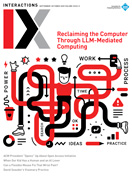Authors:
Sydney Calkin
Restrictive abortion laws don't stop abortion—they just make abortions less safe. A little over half of all pregnancies worldwide are unintended; of these unintended pregnancies, 61 percent end in abortion. Every year, 25 million unsafe abortions occur globally [1]. These unsafe abortions are the product of political choices: They are overwhelmingly concentrated in countries with the most restrictive laws. While the general trend worldwide is toward more progressive abortion laws, dramatic rollbacks of abortion rights are taking place in the U.S., Poland, and several other countries. Insights → Medication abortion pills have transformed the safety and accessibility of…
You must be a member of SIGCHI, a subscriber to ACM's Digital Library, or an interactions subscriber to read the full text of this article.
GET ACCESS
Join ACM SIGCHIIn addition to all of the professional benefits of being a SIGCHI member, members get full access to interactions online content and receive the print version of the magazine bimonthly.
Subscribe to the ACM Digital Library
Get access to all interactions content online and the entire archive of ACM publications dating back to 1954. (Please check with your institution to see if it already has a subscription.)
Subscribe to interactions
Get full access to interactions online content and receive the print version of the magazine bimonthly.






